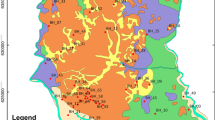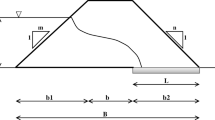Abstract
Liquefaction is one of the seismic-based disasters that has devastating economic and human life consequences. Artificial neural networks (ANN) are one of the computational methods used in liquefaction assessments. A wide range of optimization methods were used to gain the best prediction capability for ANN models. Although response surface methodology (RSM) is a widely used optimization method, a limited number of studies use RSM to optimize ANN models. This study was intended to suggest a computational model for liquefaction potential assessments. Within this scope, an ANN model was coded and optimized using the RSM. Erzurum is one of the seismically active provinces of Turkey as it is located in the East Anatolian Tectonic Structure. However, the liquefaction potential of the city has not been thoroughly examined so far. The geotechnical investigation was performed for Erzurum City Center. The specific objectives of this study are to (1) suggest a new ANN-based cyclic stress ratio (CSR) estimation method, (2) examine the usability of RSM in optimization of ANN models, and (3) perform liquefaction assessments for Erzurum City Center using the suggested method. In this context, 55 boreholes were drilled in various points of the city center. Groundwater level, soil type, and SPT-N values were determined for various depths of the boreholes. Liquefaction assessments were carried out for various earthquake scenarios (M = 6.0, 6.5, 7.0, and 7.5), considering the liquefaction severity index. Locations susceptible to liquefaction were summarized with tables and liquefaction potential maps. Liquefaction assessment maps were drawn using geographic information systems (GIS). As a result of the study, it was seen that the suggested ANN-based algorithm gives accurate results, and RSM can be used to optimize artificial neural nets efficiently.












Similar content being viewed by others
Data availability
Some or all data, models, or codes that support the findings of this study are available from the corresponding author upon reasonable request.
References
Cabalar AF, Canbolat A, Akbulut N, Tercan SH, Isik H (2019) Soil liquefaction potential in Kahramanmaras, Turkey. Geomat Nat Haz Risk 10(1):1822–1838. https://doi.org/10.1080/19475705.2019.1629106
Cetin KO, Seed RB, Der Kiureghian A, Tokimatsu K, Harder LF Jr, Kayen RE, Moss RE (2004) Standard penetration test-based probabilistic and deterministic assessment of seismic soil liquefaction potential. J Geotech Geoenviron Eng 130(12):1314–1340. https://doi.org/10.1061/(ASCE)1090-0241(2004)130:12(1314)
Cetin KO, Seed RB, Kayen RE, Moss RE, Bilge HT, Ilgac M, Chowdhury K (2018) SPT-based probabilistic and deterministic assessment of seismic soil liquefaction triggering hazard. Soil Dyn Earthq Eng 115:698–709. https://doi.org/10.1016/j.soildyn.2018.09.012
Cetin KO, Seed RB, Kayen RE, Moss RES, Bilge HT, Ilgac M, Chowdhury K (2016) Summary of SPT based field case history data of Cetin (2016) database. Technical report, No. METU/GTENG 08/16–01. Middle East Technical University
Chen Z, Li H, Goh ATC, Wu C, Zhang W (2020) Soil liquefaction assessment using soft computing approaches based on capacity energy concept. Geosciences 10(9):330
Das SK, Biswal RK, Sivakugan N, Bitanjaya D (2011). Classification of slopes and prediction of factor of safety using differential evolution neural networks. Environ Earth Sci 64, 201–210 (2011). https://doi.org/10.1007/s12665-010-0839-1
Duman ES, Ikizler SB (2014) Assessment of liquefaction potential of Erzincan Province and its vicinity. Turkey Natural Hazards 73(3):1863–1887. https://doi.org/10.1007/s11069-014-1170-
Duman ES, Ikizler SB, Angin Z (2015) Evaluation of soil liquefaction potential index based on SPT data in the Erzincan. Eastern Turkey Arabian Journal of Geosciences 8(7):5269–5283. https://doi.org/10.1007/s12517-014-1550-4
Ertek MK, Demir G (2017) Evaluation of liquefaction potential and post-liquefaction settlements in a coastal region in Atakum. Arab J Geosci 10(11):232. https://doi.org/10.1007/s12517-017-2998-9
Gandomi M, Soltanpour M, Zolfaghari MR, Gandomi AH (2016) Prediction of peak ground acceleration of Iran’s tectonic regions using a hybrid soft computing technique. Geosci Front 7(1):75–82
Gencoglu S, Ozmen B, Guler H (1996). Settlement locations and earthquake, Turkish Earthquake Foundation, Ankara (in Turkish)
Ghani S, Kumari S (2021) Liquefaction study of fine-grained soil using computational model. Innov Infrastruct Solut 6(2):1–17
Gullu H, Fedakar Hİ (2017) Response surface methodology for optimization of stabilizer dosage rates of marginal sand stabilized with sludge ash and fiber based on UCS performances. KSCE J Civ Eng 21(5):1717–1727
Idriss IM, Boulanger RW (2006) Semi-empirical procedures for evaluating liquefaction potential during earthquakes. Soil Dyn Earthq Eng 26(2–4):115–130
Iwasaki T, Tokida K, Tatsuoka F (1981) Soil liquefaction potential evaluation with use of the simplified procedure. International Conference on Recent Advances in Geotechnical Earthquake Engineering and Soil Dynamics, St. Louis, pp 209–214
Jafarian Y, Vakili R, Abdollahi AS, Baziar MH (2014) Simplified soil liquefaction assessment based on cumulative kinetic energy density: Attenuation law and probabilistic analysis. International J Geomech 14(2). https://doi.org/10.1061/(ASCE)GM.1943-5622.0000317
Kayabasi A, Gokceoglu C (2018) Liquefaction potential assessment of a region using different techniques (Tepebasi, Eskişehir, Turkey). Eng Geol 246:139–161. https://doi.org/10.1016/j.enggeo.2018.09.029
Kisi O, Keshavarzi A, Shiri J, Zounemat-Kermani M, Omran ESE (2017) Groundwater quality modeling using neuro-particle swarm optimization and neuro-differential evolution techniques. Hydrol Res 48(6):1508–1519
Koçyigit A, Canoglu MC (2017) Neotectonics and seismicity of Erzurum pull-apart basin. East Turkey Russian Geology and Geophysics 58(1):99–122. https://doi.org/10.1016/j.rgg.2016.04.015
Kurnaz FT, Kaya Y (2019) SPT based liquefaction assessment with a novel ensemble model based on GMDH-type neural network. Arab J Geosci 12:456. https://doi.org/10.1007/s12517-019-4640-5
Lentini V, Castelli F (2019) Liquefaction resistance of sandy soils from undrained cyclic triaxial tests. Geotech Geol Eng 37(1):201–216. https://doi.org/10.1007/s10706-018-0603-y
Lu J, Xu R, Li X (2015) Application of response surface methodology in organic matter soil stabilization. Electron J Geotech Eng 20(8):3633–3646
Madun A, Meghzili SA, Tajudin SAA, Yusof MF, Zainalabidin MH, Al-Gheethi AA, Md Dan MF, Ismail MAM (2017). Mathematical solution of the stone column effect on the load bearing capacity and settlement using numerical analysis. International Seminar on Mathematics and Physics in Sciences and Technology, Malaysia 28–29.
Mamoudan HRT, Kalantary F, Derakhshandi M, Ganjian N (2020) Probabilistic and deterministic assessment of liquefaction potential using piezocone data. Geotech Geolo Eng 1-15https://doi.org/10.1007/s10706-020-01511-2
Manouchehrian A, Gholamnejad J, Sharifzadeh M (2014) Development of a model for analysis of slope stability for circular mode failure using genetic algorithm. Environ Earth Sci 71(3):1267–1277
Mansouri MA, Dabiri R (2021). Predicting the liquefaction potential of soil layers in Tabriz city via artificial neural network analysis. SN Appl. Sci. 3https://doi.org/10.1007/s42452-021-04704-3
Mital U, Kawamoto R, Andrade JE (2020) Effect of fabric on shear wave velocity in granular soils. Acta Geotech 15(5):1189–1203. https://doi.org/10.1007/s11440-019-00766-1
Mollamahmutoglu M, Kayabali K, Beyaz T, Kolay E (2003) Liquefaction-related building damage in Adapazari during the Turkey earthquake of August 17, 1999. Eng Geol 67(3–4):297–307. https://doi.org/10.1016/S0013-7952(02)00190-4
Muduli PK, Das SK (2015) Evaluation of liquefaction potential of soil based on shear wave velocity using multi-gene genetic programming. In Handbook of Genetic Programming Applications (pp. 309-343). Springer, Cham.
Mughieda O, Bani-Hani K, Safieh B (2009) Liquefaction assessment by artificial neural networks based on CPT. Int J Geotech Eng 3(2):289–302
Ntritsos N, Cubrinovski M (2020) A CPT-based effective stress analysis procedure for liquefaction assessment. Soil Dyn Earthq Eng 131:106063. https://doi.org/10.1016/j.soildyn.2020.106063
Öztürk, S. (2018). Earthquake hazard potential in the Eastern Anatolian Region of Turkey: seismotectonic b and Dc-values and precursory quiescence Z-value. Frontiers of earth science, 12(1), 215-236.
Patel MS, Thaker TP (2020) Examination of present subsurface investigation data for valuation of liquefaction potential for Ahmadabad city by means of SPT-N value. In Advances in Computer Methods and Geomechanics 56:73–81. https://doi.org/10.1007/978-981-15-0890-5_7
Penirci O, Demirtaş R, Yağyemez B, Uğraş M, (2010) Geological-geotechnical survey report of Erzurum city metropolitan municipality settlement area based on 1/5000 scale master zoning plan. Erzurum. (In Turkish)
Pirhadi N, Tang X, Yang Q, Kang F (2019) A new equation to evaluate liquefaction triggering using the response surface method and parametric sensitivity analysis. Sustainability, 11(1), 112.
Samui P, Sitharam TG (2011) Machine learning modelling for predicting soil liquefaction susceptibility. Nat Hazard 11(1):1–9
Seed HB, Idriss IM (1971) Simplified procedure for evaluating soil liquefaction potential. J Soil Mech Found Div ASCE 97(9):1249–1273
Seed HB, Tokimatsu K, Harder LF, Chung RM (1985) The influence of SPT procedures in soil liquefaction resistance evaluations. J Geotech Eng 111(12):1425–1445. https://doi.org/10.1061/(ASCE)0733-9410(1985)111:12(1425)
Shahri AA (2016) Assessment and prediction of liquefaction potential using different artificial neural network models: a case study. Geotech Geol Eng 34(3):807–815
Sonmez H, Gokceoglu C (2005) A liquefaction severity index suggested for engineering practice. Environ Geol 48:81–91. https://doi.org/10.1007/s00254-005-1263-9
Tokimatsu K, Yoshimi Y (1983) Empirical correlation of soil liquefaction based on SPT N-value and fines content. Soil Found 23(4):56–74. https://doi.org/10.3208/sandf1972.23.4_56
Tunusluoglu MC, Karaca O (2018) Liquefaction severity mapping based on SPT data: a case study in Canakkale city (NW Turkey). Environ Earth Sci 77(12):422. https://doi.org/10.1007/s12665-018-7597-x
Ulusay R, Tuncay E, Sonmez H, Gokceoglu C (2004) An attenuation relationship based on Turkish strong motion data and iso-acceleration map of Turkey. Eng Geol 74(3–4):265–291. https://doi.org/10.1016/j.enggeo.2004.04.002
Wang R, Chen B, Qiu S, Ma L, Zhu Z, Wang Y, Qiu X (2018) Hazardous source estimation using an Artificial Neural Network, Particle Swarm Optimization and a Simulated Annealing Algorithm. Atmosphere 9:119. https://doi.org/10.3390/atmos9040119
Young-Su K, Byung-Tak K (2006) Use of artificial neural networks in the prediction of liquefaction resistance of sands. J Geotech Geoenviron Eng 132(11):1502–1504. https://doi.org/10.1061/(ASCE)1090-0241(2006)132:11(1502)
Zangeneh N, Azizian A, Lye L, Popescu R (2002). Application of response surface methodology in numerical geotechnical analysis." Proc. 55th Canadian Society for Geotechnical Conference, Hamilton. 2002
Zhang B, Muraleetharan KK, Liu C. (2016). Liquefaction of unsaturated sands. Int J Geomechan 16(6). https://doi.org/10.1061/(ASCE)GM.1943-5622.0000605
Author information
Authors and Affiliations
Corresponding author
Additional information
Responsible Editor: Zeynal Abiddin Erguler
Rights and permissions
About this article
Cite this article
Yılmaz, F., Öztürkoğlu, Ş. & Kamiloğlu, H. A hybrid approach for computational determination of liquefaction potential of Erzurum City Center based on SPT data using response surface methodology. Arab J Geosci 15, 95 (2022). https://doi.org/10.1007/s12517-021-09312-4
Received:
Accepted:
Published:
DOI: https://doi.org/10.1007/s12517-021-09312-4




